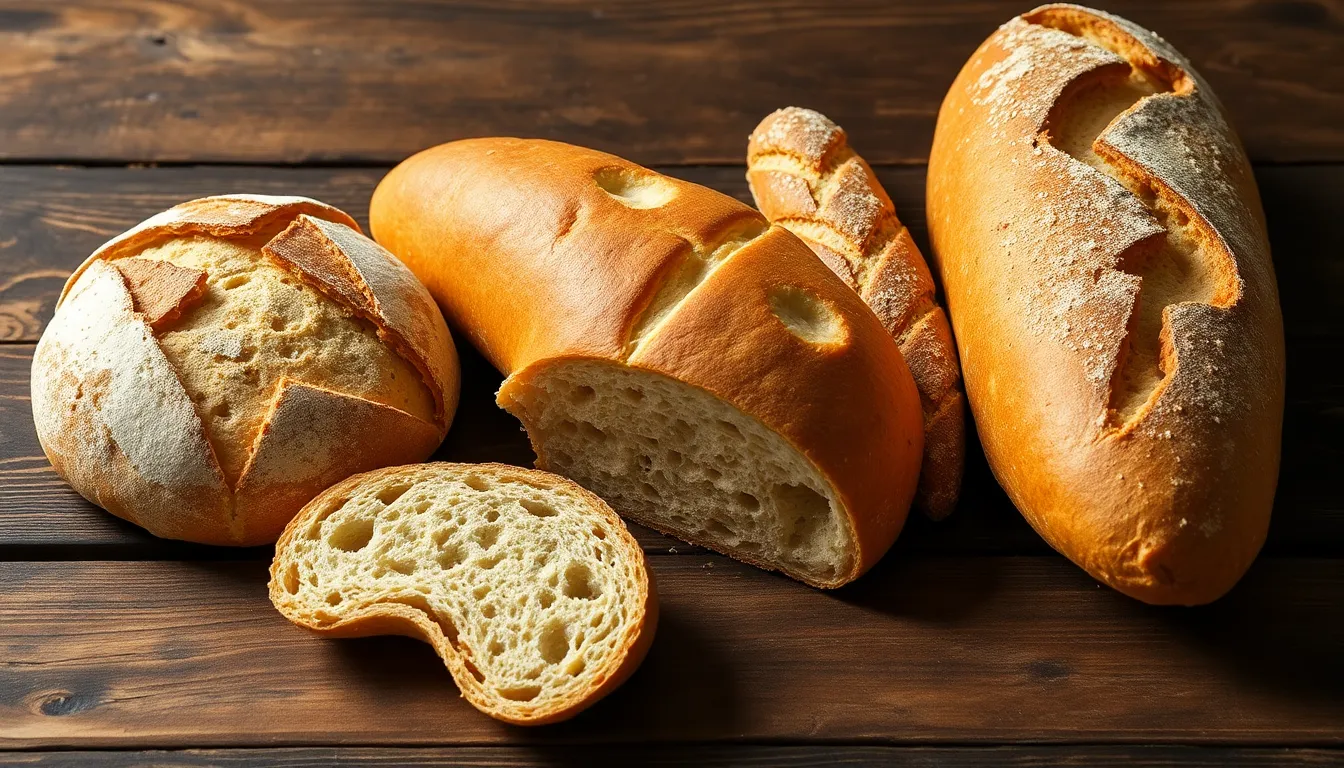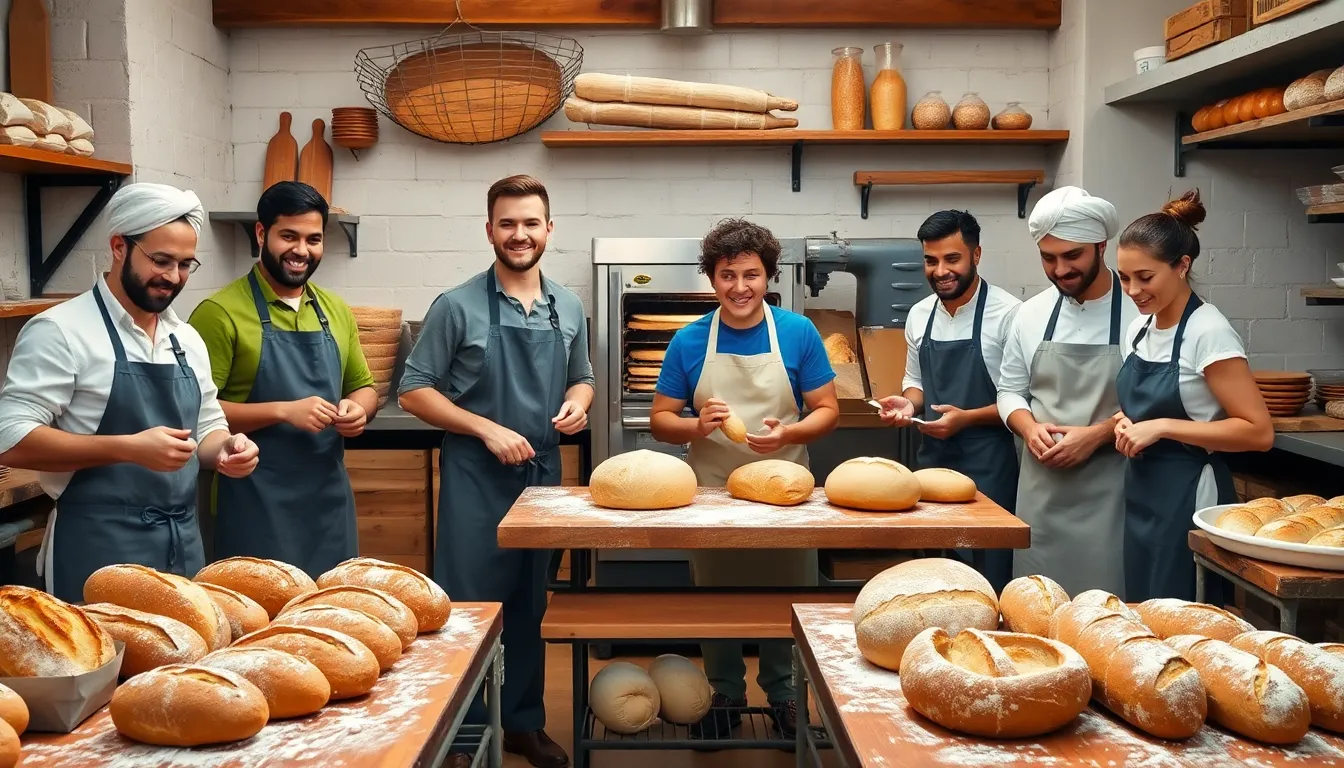In a world filled with mass-produced loaves that could double as doorstops, artisan breads stand out like a Picasso in a sea of finger paintings. These handcrafted delights are not just food; they’re a celebration of flavor, texture, and a little bit of magic. Imagine sinking your teeth into a crusty baguette or a chewy sourdough that’s been lovingly nurtured by skilled bakers. It’s like a warm hug for your taste buds.
Table of Contents
ToggleWhat Are Artisan Breads?
Artisan breads refer to handcrafted loaves made using traditional methods. They emphasize quality ingredients, often incorporating organic grains, natural leavening, and minimal processing. These breads prioritize flavor and texture, showcasing unique characteristics that differ from mass-produced options.
Common examples of artisan breads include sourdough, focaccia, and ciabatta. Each variety offers distinctive flavors and textures, often influenced by the specific fermentation process. Bakers typically allow longer rising periods, which enhances the bread’s complexity.
Artisan bakers often take pride in their craft, dedicating attention to every step of the baking process. They experiment with local ingredients, which contributes to the seasonal nature of their products. Unique adaptations, such as incorporating grains or seeds, further elevate the final product.
The sensory experience of artisan breads stands out. A freshly baked baguette presents a crusty exterior with a soft, airy interior, while sourdough boasts tangy notes balancing its chewy texture. These sensory qualities invite exploration, making each loaf a captivating experience.
Artisan breads also support local economies. Many artisan bakers source ingredients from nearby farms, fostering community connections. Buying from local bakers strengthens the local food network, ensuring freshness and promoting sustainable practices.
Overall, artisan breads represent a departure from industrial baking, celebrating craftsmanship, unique flavors, and rich textures. They embody the artistry of baking, transforming simple ingredients into exceptional culinary creations.
Types of Artisan Breads

Artisan breads encompass a variety of handcrafted loaves, each possessing unique characteristics from traditional baking methods. Three popular types include sourdough, ciabatta, and baguette.
Sourdough
Sourdough stands out for its distinct tangy flavor, a result of natural fermentation. Bakers use wild yeast and lactic acid bacteria to create a complex taste profile. This bread features a crusty exterior that contrasts with a chewy interior. Home bakers recognize its health benefits, as the fermentation process enhances digestibility. Original techniques vary widely across regions, allowing for diverse interpretations and textures. The slow rise contributes to enhanced flavor development, making it a favorite among artisan enthusiasts.
Ciabatta
Ciabatta offers a rustic appearance and airy texture, characterized by its distinctive elongated shape. The dough consists of high hydration levels, resulting in large holes and a chewy crust. Italian origins influence its flavor, showcasing a mild, slightly nutty taste. Bakers prioritize quality ingredients, often incorporating local flours and olive oil to enhance richness. Its versatility allows it to pair well with sandwiches, paninis, or simply enjoyed with olive oil. Consequently, ciabatta remains a staple choice in artisan bakeries.
Baguette
Baguette is synonymous with French baking, known for its iconic shape and crusty exterior. This bread consists of simple ingredients like flour, water, salt, and yeast, emphasizing quality over complexity. The baking technique involves creating steam in the oven, resulting in a crispy crust and soft, airy crumb. Each baguette typically measures around 26 inches long. Enjoyment often happens fresh from the oven, complemented by various toppings or cheeses. As a daily staple in France, baguette symbolizes the art of artisan baking.
The Ingredients Behind Artisan Breads
Artisan breads rely on a selection of high-quality ingredients that contribute to their unique flavors and textures. Understanding these components reveals the art behind each loaf.
Flour Varieties
Wheat flour serves as the foundation for most artisan breads. Types like all-purpose, bread, and whole wheat provide distinct characteristics. Each variety influences the dough’s hydration and texture. High-protein bread flour encourages gluten development, resulting in a chewier crumb. Additionally, specialty flours such as spelt or rye offer unique flavors and nutritional benefits. Selecting the right flour variety determines not only the bread’s structure but also enhances its overall taste experience.
Yeast and Leavening
Yeast is crucial in creating the rise and texture of artisan breads. Bakers often use natural sourdough cultures for complex flavors. This process activates wild yeasts and bacteria present in the environment, leading to a unique fermentation profile. Commercial yeasts like instant or active dry provide consistent results for quicker rises. Each leavening method contributes distinctly to the bread’s aroma and flavor complexity, affecting the final product’s character significantly.
Additives and Enhancements
Additives and enhancements elevate artisan breads to exceptional levels. Ingredients like salt play an essential role in flavor enhancement and fermentation control. Seeds, herbs, and spices introduce additional flavor layers, making each loaf a sensory experience. Whole grains and nuts enhance texture and nutritional value, offering health benefits alongside indulgent flavors. Careful selection of these additions transforms simple loaves into gourmet experiences, showcasing the creativity of artisan bakers.
The Process of Making Artisan Breads
Artisan bread-making incorporates several traditional techniques that emphasize quality and craftsmanship.
Mixing and Kneading
Mixing represents the initial stage where bakers incorporate flour, water, salt, and yeast. Hand mixing or using low-speed mixers promotes the development of gluten, enhancing the bread’s structure. Kneading follows, often done by hand for better control. This process aligns the gluten strands, creating a smooth dough that possesses elasticity. Bakers emphasize maintaining appropriate hydration levels as it affects the dough’s texture, contributing to the final loaf’s quality and flavor.
Fermentation and Proofing
Fermentation serves as a critical period for flavor development. Initially, the dough undergoes bulk fermentation, allowing natural yeasts to work their magic. This stage often lasts several hours and encourages the development of complex flavors. Following this, bakers shape the dough before proofing, which enhances its final form and texture. A properly proofed loaf demonstrates a well-aerated structure, resulting in a light and airy bite.
Baking Techniques
Baking completes the artisan bread journey, showcasing the unique characteristics developed throughout the process. Bakers utilize steam in the oven during the initial baking phase, enhancing crust development. Temperature control proves essential, as each type of bread requires specific conditions for optimal results. A properly baked loaf features a golden-brown crust, often with a crisp exterior and soft, chewy interior.
Artisan breads embody the essence of culinary craftsmanship and creativity. Each loaf tells a story through its unique flavors and textures shaped by traditional methods and high-quality ingredients. These handcrafted creations not only elevate the dining experience but also foster connections within local communities by supporting sustainable practices.
Choosing artisan bread means embracing a rich sensory journey that delights the palate. Whether savoring a tangy sourdough or a rustic ciabatta, each bite reflects the dedication and passion of skilled bakers. In a world dominated by mass production, artisan breads stand out as a celebration of authenticity and artistry in baking.



